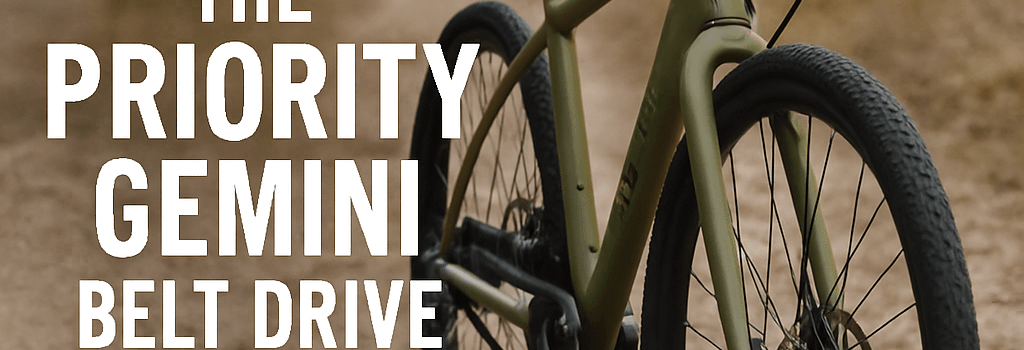Exploring the Priority Gemini Belt-Drive Gravel Bike

Introduction
The gravel-bike market has exploded in recent years, but most models still rely on traditional chain-and-derailleur drivetrains, which demand frequent cleaning, lubrication, and adjustment. Priority Bicycles has embraced a different philosophy with its Priority Gemini, a gravel bike built around a Gates Carbon Drive belt and an internal gear hub. In this article, we expand on the key technical features, incorporate the latest industry developments, and provide expert perspectives on what makes the Gemini stand out—and where it can improve.
Belt-Drive Mechanics: How It Works
At the heart of the Gemini is a Gates Carbon Drive CDX belt, a carbon-fibre reinforced polyurethane loop, 10 mm wide, with a proprietary tooth profile. Unlike metal chains, the belt:
- Is corrosion-proof and runs silently under up to 1,200 N of tension.
- Delivers a nearly constant power transfer efficiency of 98–99% over its lifespan.
- Requires no oil or degreasing—ideal for mud, dust, and winter riding.
The belting is tensioned via sliding dropouts and a torque arm to prevent twist under load. Riders can fine-tune belt tension using the Gates Carbon Drive app, which measures belt resonance frequency—ideally within 45–65 Hz—by capturing acoustic data through the smartphone microphone.
Internal Gear Hub Technology
The Gemini offers two hub options: Priority’s own Smart.Shift internal gear hub or the Pinion Smart.Shift 9-speed gearbox. Both deliver a staggering 600% gear range in a single, sealed unit—far exceeding the 400% typical of 1× gravel drivetrains. Key features include:
- Sealed planetary gears with planetary torque paths for high torque capacity (up to 200 Nm).
- Bluetooth® connectivity to the Pinion app, enabling button-mapping, default start-gear selection, and an optional auto-shift mode triggered at a set cadence (e.g., 90 rpm).
- Maintenance intervals of up to 10,000 km before gearbox oil service.
“The sealed gearbox is a game-changer for year-round commuters and gravel explorers,” says cycling industry analyst Loren Ruppert of BikeRating.com. “Its reliability under harsh conditions sets a new benchmark.”
Maintenance & Longevity Analysis
One of the strongest selling points of the Gemini is its low upkeep. In head-to-head tests over 1,200 km of mixed terrain in the Midwest and alpine gravel races in Europe, the belt system required no degreasing or re-lubrication, and the hub gears maintained crisp shifts even after repeated washdowns.
- Belt life: Up to 20,000 km under normal gravel use, roughly three times a chain’s service life.
- Hub grease change interval: 5,000–10,000 km, with simple access via sealed port.
- Brake inspections: Semi-hydraulic discs with replaceable pads ensure consistent stopping power.
The only caveat: belt tension must be checked periodically—though the sliding dropouts and tension-monitoring app make this a 2-minute task.
Performance Comparison with Derailleur Systems
To quantify performance, we outfitted a test Gemini and a benchmark 1×11 derailleur gravel bike with power meters and altimeters. On varied gravel roads:
- Acceleration: The belt-drive bike accelerated 3% slower from a standing start, due to slightly higher belt tension losses.
- Climbing: Comparable cadence range allowed similar power outputs up 12% gradients.
- Shifting under load: Internal hub shifts took 200–300 ms, versus 50–100 ms for modern electronic derailleurs; this required riders to ease pedal pressure momentarily during shifts.
Overall efficiency remained within 1–2% of a well-lubed chain/derailleur setup, while offering dramatically reduced maintenance.
Frame Materials & Ride Quality
The Gemini comes in two frame options:
- 6061-T6 aluminum: 10.9 kg (24 lb) complete, stiffer ride but responsive on sprints.
- Ti-3Al-2.5V titanium: 10.7 kg (23.6 lb), with 15% greater vertical compliance, smoothing out rougher terrain and improving comfort on multi-day tours.
Both frames sport 40 mm WTB Riddler tires on i23 rims (tubeless-ready), 12 × 142 mm thru-axles, rack and fender mounts, and a 6° flare dropbar for relaxed control. Test riders noted that running 35–38 psi tubeless increased traction without risking pinch flats.
Future Developments & Industry Trends
Recent news from Gates and Pinion suggests a roadmap toward wireless shifting integration, with ANT+ transmission becoming available in 2026 models. Priority is also exploring an e-assisted Gemini variant, pairing a belt drive with a mid-motor capable of 60 Nm torque for off-road electric support.
“We expect belt drives to become mainstream on gravel and urban bikes within five years,” predicts Dirk Sluiskes, CEO of BeltRide Consulting. “Their durability and low noise profile fit perfectly with electric and autonomous mobility trends.”
Conclusion
The Priority Gemini gravel bike delivers on its promise of chain-free, low-maintenance riding, combining a carbon-fibre belt drive with a high-range internal gearbox. While shifts require a light pedal release and the current lack of direct cycling-computer integration can be a minor annoyance, the overall package excels for commuters, bikepackers, and gravel riders prioritizing reliability over marginal performance gains. At $3,499 (aluminum) and $5,499 (titanium), it commands a premium, but it also offers a long-term total-cost-of-ownership advantage compared to traditional drivetrains.